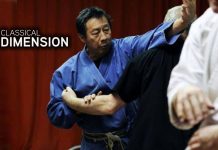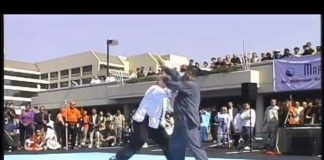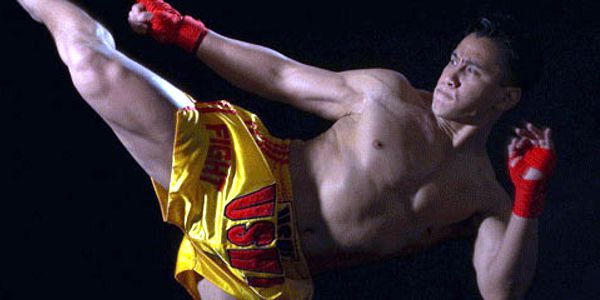 It was the shot heard around the world. Late in the third round of the Strikeforce Middleweight Championship title bout, Cung Le delivered a punishing sanshou kick to Frank Shamrock, cracking his forearm bone. After the bell, Shamrock collapsed to his knees, giving up the coveted belt to Le. Televised live on Showtime, it was one of the most thrilling MMA bouts ever, especially for fans of Chinese martial arts.
It was the shot heard around the world. Late in the third round of the Strikeforce Middleweight Championship title bout, Cung Le delivered a punishing sanshou kick to Frank Shamrock, cracking his forearm bone. After the bell, Shamrock collapsed to his knees, giving up the coveted belt to Le. Televised live on Showtime, it was one of the most thrilling MMA bouts ever, especially for fans of Chinese martial arts.
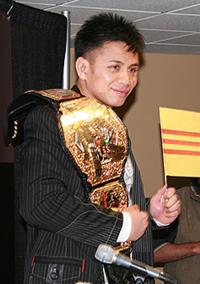 Cung Le. No sanshou champion has a fight record that can even compare. Although this was only his fifth Mixed Martial Arts fight, Le has been mixing it up since he was in high school. In 1988, he was the national champion in sambo. The following year, he added Greco-Roman and Freestyle wrestling to his sambo national champion titles. By 1990, he was a two-time All-American and the California State Wrestling Champion. Then Le discovered sanshou, China’s then newly-developed full contact fight sport. He won the national championship in 1995 and captained the American team to the World Wushu Games, a position he would hold three times for this biannual event. From then onward, Le has been the reigning king of American sanshou. Not only did he capture three bronze medals at the Worlds, Le took sanshou into the brutal bare-knuckle arenas of Shidokan and the Russian rings of Draka. In 2006, Le brought sanshou into the cage. The defeat of Frank Shamrock was Le’s sixth MMA win and maintained his undefeated record in America’s fastest growing sport.
Cung Le. No sanshou champion has a fight record that can even compare. Although this was only his fifth Mixed Martial Arts fight, Le has been mixing it up since he was in high school. In 1988, he was the national champion in sambo. The following year, he added Greco-Roman and Freestyle wrestling to his sambo national champion titles. By 1990, he was a two-time All-American and the California State Wrestling Champion. Then Le discovered sanshou, China’s then newly-developed full contact fight sport. He won the national championship in 1995 and captained the American team to the World Wushu Games, a position he would hold three times for this biannual event. From then onward, Le has been the reigning king of American sanshou. Not only did he capture three bronze medals at the Worlds, Le took sanshou into the brutal bare-knuckle arenas of Shidokan and the Russian rings of Draka. In 2006, Le brought sanshou into the cage. The defeat of Frank Shamrock was Le’s sixth MMA win and maintained his undefeated record in America’s fastest growing sport.
Two weeks after he took the belt, we met with Cung Le in his brand new gym in Milpitas, CA. Cung Le spoke to us about sanshou, MMA, as well as his role in the upcoming films Tekken and Fighting.
Sanshou in MMA
“Sanshou is the perfect stand-up art for MMA because it has all the elements – the punching, the kicking, the wrestling. It has all the elements that you need for the stand-up game for MMA. The only missing element is the ground stuff – the jiu-jitsu and the ground and pound. I think sanshou is effective because when you throw someone, you get more points in sanshou when you stay standing. If you go down with them, you’re at more of a threat to be submitted. In sanshou, you stay standing and that limits your chance of being submitted. When you take someone down in MMA, they got guillotines, they can transition to arm bars, they can roll for your leg.
“I think for me as a fighter, what I bring to the MMA cage of the ring is more exciting because I keep things going, instead of going down where there’s more of a stalemate. So if I throw someone down, people get to enjoy the throw and the action doesn’t stop because someone’s working the guard or working trying to get position. That guy gets to get up and exchange again. Now if there’s a scramble, like I had against Frank, and I’m able to scramble out of danger, that’s more exciting than being in someone’s guard and looking to pass his guard. There’s some elements of excitement when there’s ground and pound. When you get a good punch on the ground, the guy gets rocked and you get position. You’re punching him and you transition into submission. But you see that a lot. What I feel you don’t see a lot is you take one down with a high altitude throw, and you walk away and you let them come back. That was my game plan. I said I was going to sanshou Frank. And I did.
“Frank is one of those guys who likes to get in your head before the fight. During the weigh-ins, every chance he gets he’s going to try to get in your head and that’s what he tried to do to me. So basically, he got taken down, so instead of being embarrassed and getting back up, he neutralized it. People were like, ‘Ohh, look how Frank’s inviting Cung in!’ People almost forgot. How did he get down on the ground? It was a sanshou takedown. I caught his kick. I swept out his leg. He fell down. He invited me in and I said ‘no thank you.’
“What I feel is, there’s a lot of guys that are a lot smoother and a lot more fun to watch on the ground than I am. So those are the guys that you go to watch them perform and do their stuff on the ground. Now people, they get a little different element of that when they come watch me fight. My ground game is getting better. But I feel like I’m not like a Jake Shields or someone like B. J. Penn. And I’m not trying to be like them. I’m trying to make my mark as Cung Le, the kung fu sanshou fighter, transitioning into MMA. It’s who I am and it’s where I came from. I’m sticking to my roots and I’m evolving with this whole sport – a new explosion of mixed martial arts.”
Sanshou in America
“I’m keeping sanshou alive through MMA competition because right now I think sanshou in America is almost at a stand still. No one’s really helping it grow. In 2003 and 2005 I brought most of my fighters to the World Games. In 2003, we had our first gold medal, which was Elena Maxwell. In 2005, every single person who came down to train with me besides Sarah Ponce medaled. I had a couple guys on my team like Duncan Duffin and Andrew Valladeras, who were part of my team and didn’t place, but had a good showing over there. Jose Palacios was my fighter and got bronze. Elena got silver. Van Do got bronze. Max and Tiffany Chen came down and trained with me. Tiffany got the silver and then Max got bronze. I feel like the strategy and the training we put them through helped them get to that next level so they can knock off those tough countries and advance into the medaling rounds. And they were real close to being in the finals, all of them. Jose couldn’t fight in the semis to advance to the finals because of that knee injury, but he made it to the semis.
“I just feel that sanshou isn’t being pushed right by certain people. In 2007, I was asked to ‘maybe’ host the team trials. Usually I have my own event, Born to Fight, at a high school and that’s where I was going to host it. And then I ended renting the San Jose Civic Center to make it more prestigious and get as much media there as possible. Then I get a curve ball from the U.S.A Wushu Kungfu Federation saying that they’re going to host it in Texas and have a different coach. For what I’ve done for USAWKF, I felt like they turned their back on me. I still kept it open. I told all my fighters, ‘I’m not going to go to the team trials this year and it’s up to you if you want to go,’ and they all stayed with me. I just felt like for all the things that I’ve been doing – pushing sanshou and kung fu – I didn’t get the backing. And look what happened. It ended up that no one placed. We had no one place at the 2007 World Games.
“If it’s working, don’t change it. Max, Tiffany, everyone who was supposed to be here in camp training, because that’s what we had planned. I’m sad about that but there’s nothing I can do about it. I had open doors. I had actually spent a lot of money to get the Civic Center to promote the event. I know Tat Wong was trying to push for me to get it but it was out of his hands because he didn’t have that much control. The sanshou division was not even deep at the Born to Fight. Everyone was fighting muay thai or doing jiu-jitsu now. When there’s a team trials, everyone would come out and support it and we’d have a lot of fights. I just felt like ‘what a blow to sanshou’ and they don’t even realize what they did.
“I would have loved to be the coach last year. I was ready. I put my own money in it. My fighters were revving up to do it. And instead, when they threw that curve ball, I ended up getting my fighters fights on Bodog TV. It was a lot more exposure and they got paid for it. They threw a curve ball and me and all the athletes suffered. And you know what? I didn’t have to go all the way out there. I didn’t have to coach. I didn’t have to be stressed, because when I coach, it’s like my own kids out there fighting. So in a way, they did a favor for me, but they hurt themselves.
“I’m always open to support sanshou. They have to show a little more support. What they did – I feel like I got stabbed in the back. Elena, she was torn, but I told her, ‘If you want to go and compete, do it.’ To take away something – this is what I don’t understand. Our base here, we have Van, bronze medalist, we have Jose, bronze medalist, we have Elena who is a gold and silver medalist. Then you have Max and Tiffany that were ready to come down here. Sarah Ponce was ready to come here and all train together. And then to pull it to Texas? It did not make any sense. I think it was just a buddy-buddy deal with Anthony Goh and the coach – I don’t even know his name. You want to do what’s best for the athlete, not what’s best for your buddy. I think things like that doesn’t help the sport at all. That’s why I’m speaking up. I feel like I’ve put in my dues. Who’s this guy who’s never really done anything for the U.S.A. or the USAWKF like I have done, for him to host the tournament and him to be coach? It made me feel like, ‘Wow, ok, if they aren’t going to support me, why should I keep supporting sanshou?’ But I’m open. They need to come to me and officially invite me. If not, you’ll just see Cung Le on the big screens and when we fight it’ll say ‘Style: Sanshou / MMA’.”
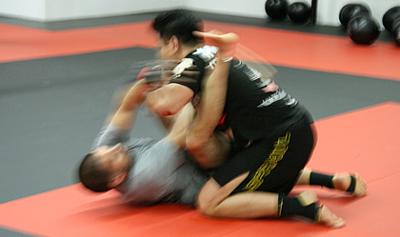
MMA in Sanshou
“There’s different methods of training in sanshou and MMA. MMA is constantly evolving. The techniques and the methods of training in MMA can really benefit sanshou fighters. One is conditioning. In MMA, you have to be in top conditioning. I was never in the level of competition shape in sanshou as I am in MMA, because you have to be well-rounded from the ground all the way to your stand up. You have to be sharp, all the way through. In sanshou, you just score points. It comes down to who’s stronger and who’s better conditioned. Most of the time, it’s the Russians and the Chinese. For me, when I beat the top Chinese fighter in 1999 – if you watch the fight, I fought the Mongolian King – it was pressure, it was being in their face and it was my game plan that I put together. Pressure fighting. In order to pressure fight, you have to be in the best shape and you have to be able to defend against wrestling and defend against their shuai jiao (throws +Chinese+) moves. I dominated the fight. From there on, my training evolved. That’s why when I coached the team, we had guys that were able to go in and medal and win the world championships because of that method. Now I’ve learned so much in MMA – not that I want to give away all my training methods – there’s so many different drills – explosive drills – that are perfect for sanshou.
“We still train sanshou. We have a full sanshou program, but we also have a full MMA program and a full jiu-jitsu program and a full fitness program. I think sanshou is a big element to become a more complete fighter. Because now, since there’s really no money in sanshou – you basically pay to go to the tournaments and you pay to compete – and there’s really not that much exposure, nothing like MMA. We use our foundation of sanshou to have the upper hand in the MMA ring.”
Sanshou on the Silver Screen
“Tekken is going to come out. For people who want to follow my movie career, they can look up IMDB.com. Tekken hasn’t been popped up yet. Tekken should be popped in, but I’m not sure when. I play Martial Law.
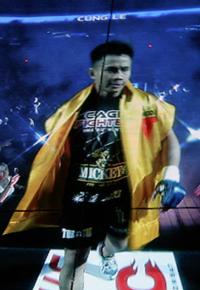 “I got another movie that’s a big one that’s coming out at the end of the year. It’s called Fighting. Channing Tatum, you might know, he’s the lead for G. I. Joe, the movie – he was the lead in Fighting. I play opposite of Channing in probably one of the best fights in that movie. We had a fight coordinator, Mike Gunther, who’s on The Fast and the Furious sequel right now. It’s about underground fighting in the streets of New York. I play the King of the Underground. In this movie, I do some sanshou moves. You may see my scissor in there. And the way they did it, it’s a very different storyline. Terrance Howard is in there, Academy Award nominee, and Luis Guzmán. Since it’s going to be released in the big screens, it’s going to be a big one for martial arts in general because they got real martial artists in there who fight in the cage and who came from traditional martial arts backgrounds. Everyone else are actors or street brawlers.
“I got another movie that’s a big one that’s coming out at the end of the year. It’s called Fighting. Channing Tatum, you might know, he’s the lead for G. I. Joe, the movie – he was the lead in Fighting. I play opposite of Channing in probably one of the best fights in that movie. We had a fight coordinator, Mike Gunther, who’s on The Fast and the Furious sequel right now. It’s about underground fighting in the streets of New York. I play the King of the Underground. In this movie, I do some sanshou moves. You may see my scissor in there. And the way they did it, it’s a very different storyline. Terrance Howard is in there, Academy Award nominee, and Luis Guzmán. Since it’s going to be released in the big screens, it’s going to be a big one for martial arts in general because they got real martial artists in there who fight in the cage and who came from traditional martial arts backgrounds. Everyone else are actors or street brawlers.
“Right now I’m doing the Bo Jackson thing. I’m doing both – fighting and film. During the fight against Sam Morgan, I was filming Fighting. When I did that movie with David Carradine, Eric Roberts and Gary Busey, (Blizhniy Boy: The Ultimate Fighter) I fought two different fights. I fought Mike Altman, my first MMA fight, and I fought Brian Warren and broke my nose. The following year, I was shooting Fighting with Channing Tatum and Terrence Howard and I fought Sam Morgan. All those three fights were during the time I was filming.
“And believe it or not – I don’t want to say this but my promoter, he can’t get mad at me now – I trained for three months for Frank Shamrock. I took one week off but I did bring my trainer, Javier Mendez, to Shreveport, Louisiana when I filmed Tekken. I filmed out there for a week. I told my promoter that I got injured training, but truly it was the lead actor, Jon Foo, who punched me and gave me twenty-one stitches, one month before the fight. So there it is. That’s exclusive.”
Is Cung Le Traditional?
“I have a black belt in Taekwondo. I’ve studied Vietnamese kung fu. I had like five forms down. I started out in traditional martial arts. Vietnamese kung fu is famous for their scissor to the neck. But I evolved the kick into scissor to the body or the leg for the takedown. Now I’m looking to evolve it to MMA, which I haven’t perfected yet because MMA is so deadly all around. You do something where your ankles are exposed and they got a foot-lock. If your knees are exposed, you got knee-locks. But I’m going to find a way to get it in there.
“Here’s where I show I’m traditional. It’s how I carry myself. MMA fighters who’ve never had traditional martial arts training, they walk in, they put their arm up to the crowd or however they do it. How do I walk into the cage? I salute four corners, traditionally. Always be respectful. After I won, I was gracious. I came over to Frank and I gave him a salute and shook his hand. I mean Muay Thai fighters can say a front kick catch sweep is a Thai sweep, but it’s a sanshou sweep. It’s a universal technique. My kicks are different from all the other MMA kickers. Those are traditional martial arts kicks.
“I want to thank the kung fu and traditional martial arts community for supporting me and I’ll do my best in both worlds, in mixed martial arts and the film world. I’m very grateful who I’ve become.”
Written by Gene Ching for KUNGFUMAGAZINE.COM
© COPYRIGHT KUNGFUMAGAZINE.COM, ALL RIGHTS RESERVED.
All other uses contact us at gene@kungfumagazine.com


